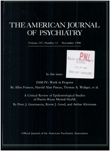Some correlates of prospectively defined premenstrual syndrome
Abstract
Correlates of prospectively defined premenstrual syndrome were investigated in 50 women who visited a premenstrual syndrome clinic. To assess premenstrual symptom change relative to daily change, the author used effect size, the difference in mood ratings between the post- and premenstrual phases divided by the standard deviation of the entire cycle. Only 12 women had an effect size greater than or equal to 1.0 in two cycles. The probability of having premenstrual syndrome was positively related to working outside the home and negatively related to age. The results underscore the need to use prospective diagnostic criteria in research on premenstrual syndrome.
Access content
To read the fulltext, please use one of the options below to sign in or purchase access.- Personal login
- Institutional Login
- Sign in via OpenAthens
- Register for access
-
Please login/register if you wish to pair your device and check access availability.
Not a subscriber?
PsychiatryOnline subscription options offer access to the DSM-5 library, books, journals, CME, and patient resources. This all-in-one virtual library provides psychiatrists and mental health professionals with key resources for diagnosis, treatment, research, and professional development.
Need more help? PsychiatryOnline Customer Service may be reached by emailing [email protected] or by calling 800-368-5777 (in the U.S.) or 703-907-7322 (outside the U.S.).



